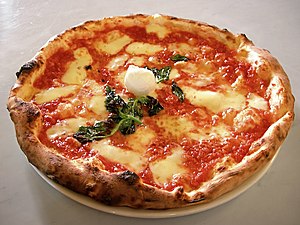 | |
| Alternative names | Margherita pizza |
|---|---|
| Type | Pizza |
| Place of origin | Naples |
| Region or state | Italy |
| Created by | Raffaele Esposito |
| Invented | 1889 |
| Main ingredients | Tomatoes, mozzarella, basil, extra virgin olive oil |
| Part of a series on |
| Pizza |
|---|
| Main articles |
Styles
|
| Topping varieties |
| Cooking variations |
| Tools |
| Events |
| Frozen pizza brands |
| Lists of pizza chains |
| By country |
| Related articles |
| Similar dishes |

Pizza Margherita or Margherita pizza is a typical Neapolitan pizza, roundish in shape with a raised edge (the cornicione) and garnished with hand-crushed peeled tomatoes, mozzarella (buffalo mozzarella or fior di latte), fresh basil leaves, and extra virgin olive oil. The dough is made by mixing water, salt, and yeast (either sourdough, or fresh or dry baker's yeast) with flour (00 or 0).

The dough is stretched by the pizzaiolo ('pizza maker') in a motion going outwards from the center, pressing with the fingers of both hands on the dough ball, and flipping it several times, shaping it into a disc. It is then topped and baked in an oven, which is traditionally made of brick and wood-fired (electric or gas ovens are also used). Pizza Margherita is usually served hot on a plate or folded into four and wrapped in paper (pizza a portafoglio or a libretto).
History

A popular contemporary legend holds that the archetypal pizza Margherita was invented in June 1889, when the Royal Palace of Capodimonte commissioned the Neapolitan pizzaiolo Raffaele Esposito to create a pizza in honor of the visiting Queen Margherita. Of the three different pizzas he created, the queen strongly preferred a pizza swathed in the colors of the Italian flag—red (tomato), green (basil), and white (mozzarella). Supposedly, this type of pizza was then named after the queen, with an official letter of recognition from the queen's "head of service" remaining to this day on display in Esposito's shop, now called the Pizzeria Brandi. Later research cast doubt on this legend, undermining the authenticity of the letter of recognition, pointing that no media of the period reported about supposed visit and that both the story and name Margherita were first promoted in the 1930s–1940s.
The origins of pizza Margherita came from mixing similar toppings that were already present in Naples between 1796 and 1810. In 1849 Emanuele Rocco recorded different pizza toppings including basil, tomatoes, and thin slices of mozzarella; the mozzarella was thinly sliced, and added to the toppings already present.
In 1866, Francesco De Bourcard, writing about the Naples traditions, described the most commonly used pizza toppings at that time as well as the possible origin of calzone:
The most ordinary pizza, called coll'aglio e l'olio (lit. 'with garlic and oil'), is dressed with oil, and over it is spread, as well as salt, origanum, and garlic cloves shredded minutely (optionally). Others can be covered in grated cheese and dressed with lard, and then they put on a few leaves of basil. Over the former is often added (depending on the region) some small seafish; on the latter some thin slices of mozzarella. Sometimes they use slices of prosciutto, tomato, arselle, etc. Sometimes folding the dough over itself to form what is called calzone.
Gallery
See also
![]() Media related to Pizza Margherita at Wikimedia Commons
Media related to Pizza Margherita at Wikimedia Commons
References
- Google Books ngrams comparing "pizza Margherita" and "Margherita pizza" in English books -- https://books.google.com/ngrams/graph?content=pizza+Margherita%2CMargherita+pizza&year_start=1950&year_end=2019&corpus=en-2019&smoothing=3
- "Margherita Pizza". La Cucina Italiana. 9 November 2021. Retrieved 18 June 2024.
- ^ "Il disciplinare dell'Associazione Verace Pizza Napoletana". AVPN (in Italian). Retrieved 2024-02-02.
- "Cottura pizza: qual è davvero la migliore cottura per la pizza?". pizzastories.le5stagioni.it. Retrieved 2024-02-02.
- "Where to Eat Traditional Pizza a Portafoglio in Naples". La Cucina Italiana. 2019-09-11. Retrieved 2024-02-02.
- D'Angelo, Giuseppe A. (2021-02-15). "Pizza a portafoglio in Naples: what is, where to eat it, and the recipe for home cooking". Pizza DIXIT. Retrieved 2024-02-02.
- Iengo, Arturo (2008). Cucina Napoletana: 100 Recipes from Italy's Most Vibrant City. New Holland Publishers. p. 126. ISBN 978-1-84537-989-6. Archived from the original on 2018-06-16. Retrieved 2017-12-12.
- "Pizza Margherita: History and Recipe". Italy Magazine. 14 March 2011. Archived from the original on 7 February 2013. Retrieved 23 April 2012.
- Hales, Dianne (2009-05-12). Sök på Google (in Swedish). Crown. ISBN 978-0767932110. Archived from the original on 2022-02-21. Retrieved 2018-04-04.
- "Was margherita pizza really named after Italy's queen?". BBC Food. 28 December 2012. Archived from the original on 31 December 2012. Retrieved 31 December 2012.
- Nowak, Zachary (March 2014). "Folklore, Fakelore, History: Invented Tradition and the Origins of the Pizza Margherita". Food, Culture & Society. 17 (1): 103–124. doi:10.2752/175174414X13828682779249. ISSN 1552-8014. S2CID 142371201.
- Forgione, Angelo (2013). Made in Naples. Magenes. p. 195. ISBN 978-88-6649-039-5.
- ^ De Bourcard, Francesco (1866). Usi e costumi di Napoli e contorni descritti e dipinti [Uses and customs of Naples and outlines described and painted.]. Vol. 2. G. Nobile. p. 124.
Bibliography
- De Bourcard, Francesco (1866). Usi e costumi di Napoli e contorni descritti e dipinti. Naples.
{{cite book}}: CS1 maint: location missing publisher (link)


